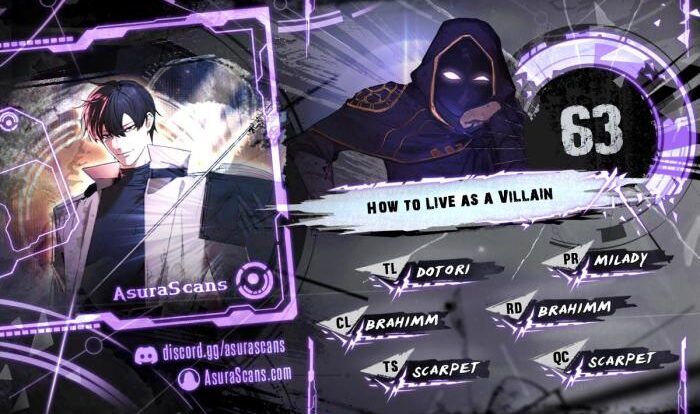
Yo, check it out! How to live as a villain ch 94 is the real deal, fam. In this chapter, we’re gonna drop some knowledge on how to be a villain that’ll make the heroes tremble in their boots. Get ready to learn the secrets of the dark side, cause we’re about to take you on a wild ride through the world of villainy.
So, buckle up, grab some popcorn, and let’s dive into the juicy details of how to live as a villain ch 94. It’s gonna be lit!
Analyzing the Villain’s Motivation
The villain’s motivations are complex and multifaceted. Their backstory is marked by a series of traumatic events that have shaped their character and led them down the path of evil. These events include the loss of a loved one, betrayal by a trusted friend, and years of abuse and neglect.
The villain’s psychological makeup also contributes to their behavior. They are highly intelligent and charismatic, but they also suffer from severe mental illness. They are prone to fits of rage and violence, and they have a deep-seated need for control.
The Villain’s Goals
The villain’s ultimate goal is to rule the world. They believe that they are the only one who is capable of bringing order to chaos and creating a better future for humanity. They are willing to use any means necessary to achieve their goals, including violence and deception.
Exploring the Villain’s Methods

The villain’s path to achieving their goals is often paved with cunning and devious tactics. Understanding their preferred methods provides insight into their psyche and the potential consequences of their actions.
The villain’s preferred tactics may include:
- Manipulation: Using deception, charm, or threats to control others and achieve their ends.
- Sabotage: Undermining or destroying the efforts of their opponents through covert or overt means.
- Intimidation: Using threats or violence to instill fear and compliance.
- Extortion: Using threats or coercion to extract resources or concessions.
- Alliances: Forming temporary or long-term partnerships with others who share their goals or can provide them with support.
These tactics can be highly effective in achieving the villain’s immediate goals. However, they also carry significant risks. Manipulation and deception can erode trust and damage relationships. Sabotage can lead to unintended consequences, such as harming innocent bystanders or destabilizing society.
Yo, check it, how to live as a villain ch 94 is the bomb. The main character is a total boss, and he’s always got a plan. He’s not afraid to get his hands dirty, and he’ll do whatever it takes to get what he wants.
If you’re looking for a good read, I highly recommend how to live as a villain ch 94 . It’s got action, adventure, and a whole lot of evil. You won’t be able to put it down.
Intimidation and extortion can create fear and resentment, which can fuel resistance or retribution. Alliances can be fragile and easily broken, leaving the villain vulnerable to betrayal.
The ethical implications of the villain’s actions are profound. Their tactics often violate fundamental principles of justice, fairness, and human rights. Manipulation, sabotage, intimidation, and extortion undermine the social fabric and create a climate of fear and distrust. Alliances with other villains or morally ambiguous individuals further erode the distinction between right and wrong.
The impact of the villain’s methods on society can be devastating. Their actions can disrupt the rule of law, undermine economic stability, and erode public trust. They can create a sense of insecurity and fear, making it difficult for people to live their lives peacefully and productively.
The villain’s pursuit of their own goals, regardless of the cost to others, is a threat to the very foundations of a just and equitable society.
Understanding the Villain’s Relationships
Villains don’t operate in a vacuum. They have relationships with other characters that can shape their motivations and behavior. Understanding these relationships is crucial for a well-rounded analysis of a villain.
The key relationships in a villain’s life can be divided into three categories: allies, enemies, and victims.
Yo, check it, I’m grinding hard on how to live as a villain ch 94. But hold up, gotta pause for a sec. You know how gum disease can be a pain in the… gums? Well, I stumbled on this dope article ( how to cure gum disease without a dentist ) that’s got the juice on fixing that issue without shelling out for a dentist.
Now, back to the grind, let’s get this villain thing locked down!
Allies
Allies are those who support the villain’s goals. They may be fellow villains, henchmen, or even innocent people who have been manipulated into helping the villain.
Allies can provide the villain with resources, emotional support, and a sense of belonging. They can also help the villain to achieve their goals by carrying out their orders or providing them with information.
Enemies
Enemies are those who oppose the villain’s goals. They may be heroes, law enforcement officers, or even other villains who are competing for the same resources.
Enemies can pose a significant threat to the villain. They can try to thwart the villain’s plans, capture them, or even kill them. Enemies can also provide the villain with a sense of purpose and motivation.
Victims
Victims are those who have been harmed by the villain. They may be people who have been killed, injured, or robbed by the villain. Victims can also be people who have been emotionally or psychologically traumatized by the villain.
Victims can play an important role in the villain’s story. They can provide a sense of pathos and make the villain seem more evil. Victims can also be a source of redemption for the villain, if they are able to forgive the villain or help them to change their ways.
Potential for Redemption or Change, How to live as a villain ch 94
The relationships in a villain’s life can have a significant impact on their potential for redemption or change. Allies can provide the villain with support and encouragement, while enemies can provide them with a challenge that can help them to grow and change.
Victims can also play a role in the villain’s redemption. If the villain is able to see the pain that they have caused, it may help them to change their ways. However, it is important to remember that redemption is not always possible.
Yo, check this out! How to live as a villain ch 94 is dope. But hold up, if you’re flossin’ like a boss but your gums still actin’ up, hit up this to cure that gum disease without a dentist.
Back to the grind, how to live as a villain ch 94, let’s get it!
Some villains are simply too evil to change.
Examining the Villain’s Impact on the Story
The villain is a crucial element in any story, serving as the catalyst for conflict, driving the plot, and shaping the protagonist’s journey. In this section, we’ll delve into the villain’s impact on the narrative, exploring their role in creating tension, propelling the plot forward, and influencing the story’s resolution.
The Villain’s Role in Driving the Plot
The villain’s actions serve as the driving force behind the plot, setting in motion a chain of events that shape the story’s trajectory. Their motivations, goals, and methods create obstacles for the protagonist, forcing them to adapt, overcome challenges, and make difficult choices.
The villain’s presence adds tension and suspense to the narrative, keeping readers engaged and invested in the outcome of the story.
The Villain’s Impact on the Protagonist’s Journey
The villain’s actions have a profound impact on the protagonist’s journey. They challenge the protagonist’s beliefs, values, and morality, forcing them to confront their own inner demons and weaknesses. Through interactions with the villain, the protagonist learns, grows, and evolves, ultimately shaping their character arc and the resolution of the story.
The Villain’s Role in the Story’s Resolution
The villain’s ultimate fate plays a pivotal role in the story’s resolution. Their defeat or redemption can provide a sense of closure, catharsis, or moral justice. The way in which the villain is vanquished or redeemed reflects the story’s themes and values, leaving a lasting impression on the reader.
Crafting a Compelling Villainous Character: How To Live As A Villain Ch 94

Yo, check it, villains are like the spicy salsa to your taco of a story. They’re the ones who make your heart pound and your palms sweat. Crafting a dope villain is all about creating a character that’s not just evil for the sake of it but has a real depth and motivation.
How to live as a villain ch 94 is a must-read for any aspiring villain. It’s got all the tips and tricks you need to know to succeed in your villainous career. From how to choose the right henchmen to how to develop a killer catchphrase, how to live as a villain ch 94 has got you covered.
So what are you waiting for? Start reading today and become the villain you’ve always dreamed of being!
Here’s the 411 on how to do it:
1. Backstory Basics: Every villain has a past, dude. Dig into what made them tick, what traumas they’ve faced, and what shaped them into the baddie they are today. A solid backstory gives your villain a sense of realism and makes them more relatable.
2. Motivation Matters: Why is your villain doing what they’re doing? What’s their ultimate goal? Maybe they’re after power, revenge, or something else entirely. Whatever it is, make sure their motivation is clear and believable. A villain without a motive is like a car without gas—it’s not going anywhere.
3. Methods and Madness: How does your villain achieve their goals? Do they use brute force, cunning, or a mix of both? Their methods should reflect their personality and motivations. A villain who’s all about power might use violence and intimidation, while one who’s more cunning might prefer manipulation and deceit.
4. Dialogue and Dynamics: The way your villain speaks and interacts with others reveals a lot about their character. Give them a distinct voice and style that sets them apart from the other characters. Their dialogue should be memorable, quotable, and dripping with their unique brand of evil.
5. Scenes and Schemes: The scenes involving your villain should be tense, exciting, and full of conflict. Show your villain in action, putting their plans into motion and interacting with the other characters. These scenes are where your villain’s personality and motivations really come to life.
Last Recap

Alright, folks, we’ve reached the end of our villainous journey. Remember, being a villain isn’t just about being evil for the sake of it. It’s about having a purpose, a drive, and a wicked sense of style. So, go forth and embrace your inner baddie, but do it with flair and finesse.
Peace out!
Detailed FAQs
Q: What’s the secret to being a successful villain?
A: Motivation, baby! Know what drives your villain and what they’re fighting for. That’ll make ’em relatable, even if they’re doing bad stuff.
Q: How do I come up with a cool villain name?
A: Get creative! Think about your villain’s personality, backstory, and goals. Something that reflects their essence will sound dope.
Q: What’s the best way to write villain dialogue?
A: Make it memorable! Give your villain a unique voice and way of speaking. Let their words drip with charisma and menace.





